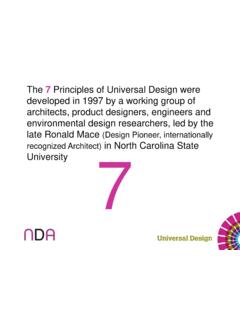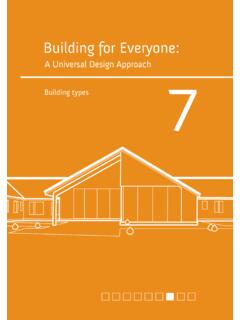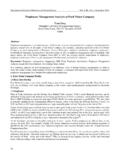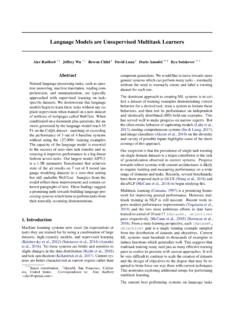Transcription of A Universal Design Approach 1
1 A Universal Design ApproachBuilding for Everyone:External environment and approach1 IICentre for Excellence in Universal DesignCreating an environment that can be used by all people, regardless of their age, size, disability or ability. The National Disability Authority s Centre for Excellence in Universal Design has a statutory role to promote the achievement of excellence in Universal Design in: the Design of the built and external environment product/service Design information and communications technologies (ICT) the development and promotion of standards education and professional development raising awareness of Universal designMore information and updates on the website at: for EveryoneBooklet 1 - External environment and approachThe other booklets from the Building for Everyone series:Booklet 2 - Entrances and horizontal circulationBooklet 3 - Vertical circulationBooklet 4 - Internal environment and servicesBooklet 5 - Sanitary facilitiesBooklet 6 - Facilities in buildingsBooklet 7 - Building typesBooklet 8 - Building managementBooklet 9 - Planning and policyBooklet 10 - Index and terminologyii Contents Objectives Introduction Terminology Design Issues Topographical constraints Safety and convenience A balance of needs Vehicular Environments Car park provision Car parking spaces Car parking signage Designated car parking spaces Multi-storey and underground car parks Paid parking Setting-down points Taxi ranks Pedestrian environments Access routes Drainage Guardrails Changes in level External ramps Handrails Ramp surface and edge protection
2 External steps Surface materials Natural and tempered landscapes Urban environments Street furniture Lighting and signage Placement of street furniture Bins Bollards Gates Drinking fountains Seating Pedestrian crossing points Tactile paving surfaces Blister surface for pedestrian crossing points Corduroy paving for hazards Protection of Outdoor Works Construction sites Roadway and pavement maintenance 89A1 Definition of Universal Design 90A2 Human Abilities and Design 90A3 Further Reading 95 List of Illustrations 99 Index 1014 Objectives The guidance in this booklet promotes the concept and philosophy of Universal Design and encourages developers, designers, builders and building managers to be innovative and think creatively about solutions that meet the needs of all building objectives of the series of booklets are to: identify and promote best practice with regard to Universal Design of the built and external environment provide best practice guidelines while recognising existing regulations in Ireland provide guidelines that are usable by and accessible to the target audience promote the achievement of Universal Design in IrelandThis booklet aims to.
3 Identify and promote best practice for access to and understanding of the external environment and Approach to buildings with regard to Universal Design increase awareness of, and encourage designers to identify, the needs of all those who require access to the external environment in order to undertake daily activities highlight the wider benefits experienced by all when accessible and Universal Design features of the external environment and approaches to buildings are provided encourage designers to provide Universal Design solutions for the external environment and approaches to buildings that look beyond the recommended requirements of national building regulations5 Introduction This booklet is part of the series Building for Everyone A Universal Design Approach , which aims to provide practical guidance on the Universal Design of buildings, places and Design places human diversity at the heart of the Design process so that buildings and environments can be designed to meet the needs of all users.
4 It therefore covers all persons regardless of their age or size and those who have any particular physical, sensory, mental health or intellectual ability or disability. It is about achieving good Design so that people can access, use, and understand the environment to the greatest extent and in the most independent and natural manner possible, without the need for adaptations or specialised solutions (see full definition in Appendix A1). Why Universal Design ?People are diverse - some are left-handed and some right-handed - and vary in their age, size and functional capacities. Illness or disability (whether temporary or permanent) can also affect characteristics such as a person s mobility, dexterity, reach, balance, strength, stamina, sight, hearing, speech, touch, knowledge, understanding, memory, or sense of direction. A reference list with these booklets indicates some of the key differences in human abilities that should guide the Design of buildings and of outdoor places.
5 (See full description of Human Abilities in Appendix A2).People of diverse abilities should be able to use buildings and places comfortably and safely, as far as possible without special assistance. People should be able to find their way easily, understand how to use building facilities such as intercoms or lifts, and know what is a pedestrian facility and where they may encounter the wide diversity of the population, a Universal Design Approach , which caters for the broadest range of users from the outset, can result in buildings and places that can be used and enjoyed by everyone. That Approach eliminates or reduces the need for expensive changes or retro fits to meet the needs of particular groups at a later is good practice to ascertain the needs of the range of expected users as early as possible, and to check the practicality and usability of emerging designs with a diverse user for one group can result in solutions that address the needs of many others. For example: level entry (Step-free) entrances facilitate not just wheelchair users but also people with buggies; people with suitcases or shopping trolleys; people using walking or mobility aids; and people with visual difficulties larger toilet compartments provide easier access to wheelchair users; those with luggage or parcels; parents with pushchairs or accompanying small children; those using walking or mobility aids; and larger-sized people clear, well-placed signage that uses recognised symbols or pictograms helps people with reading or cognitive difficulties, and those whose first language is neither English nor IrishSometimes one solution will not suit all and a range of options will need to be provided.
6 For example: providing both steps and a ramp where there is a change in level providing parking ticket machines that offer slots at different heights to facilitate use at standing height, sitting height, and by people of small statureThis series of booklets is for architects, engineers, planners, developers, designers, building contractors, building workers, building managers and others involved in designing, commissioning and managing buildings and their surroundings. It provides guidance on a Universal Design Approach to all new buildings, and the use and adaptation of existing who commission, Design , construct or manage any part of the built and made environment also have a duty of care to adhere to relevant legislation and regulations including equality legislation, building regulations and health and safety guidance is based on a best practice Approach , drawing on up-to-date international best practice; guidelines and standards; previous guidance by the National Disability Authority; and extends beyond disability access matters to incorporate a Universal Design Approach .
7 The series is fully compatible with Part M (2010) of the Building Regulations and associated Technical Guidance Documents related to Part disability access certificate is required for new buildings other than dwellings (including apartment buildings) and certain other works (as set out in Article 20 D (1) of SI 351 of 2009) to which the Requirements of Part M of the Building Regulations apply, which commence or take place on or after 1 January 2012. Further details on these and other relevant standards, codes of practice, and professional codes of practice are listed in Appendix A3 Further detailed guidance provided here does not represent the only possible solution. Designers may come up with other ways to meet a diversity of users. New materials and technologies that emerge may open up further possibilities of accommodating the diversity of the are provided throughout the series and while they provide a summary of main considerations and technical criteria, they should not be regarded as a substitute for the main text or an exhaustive list.
8 A comprehensive index is also available for the suite of booklets. The Building for Everyone series is available online at and Electronic links are provided to relevant sections in the different booklets. As standards and requirements develop, the electronic versions of these booklets will be electronic version is produced in accessible PDF format, in accordance with the Web Content Access Guidelines If you have any difficulties in this regard or require the document, or particular sections, in alternative formats, please contact the Centre for Excellence in Universal Design at the National Disability Authority, or (01) Terminology Accessible Design Design focussed on principles of extending standard Design to people with some type of performance limitation to maximize the number of potential customers who can readily use a product, building or route Any route in an internal or external environment whether it is level, gently sloped, ramped or stepped that is available and understandable for a person to use.
9 In external environments, access routes comprise paths, pavements and other pedestrian routes, such as a right of way through a public A permanent or temporary structure of any size that accommodates facilities to which people have access. A building accommodating sanitary facilities may include a toilet block in a public park or shower facilities at a campsite. A temporary building may include portable toilet facilities such as those provided at outdoor user A person regardless of age, size, ability or disability using facilities in a building or associated external car parking Car parking spaces reserved for the use of car users with disabilities, whether as motorists or kerbs A lowered section of kerb between a pavement and carriageway forming a level or flush crossing point. Also referred to as dished or grill An opening of several slits side by side in a wall or metal sheet or other barrier, usually to let air or water enter and/or leave but keep larger objects including people and animals in or to falls Paving and drainage that relies on fall to carry away water.
10 Fall may also be referred to as slope or, more correctly, gradient. By making one part of the pavement higher than another, gravity will cause the water to move in a preferred and ride The formal provision of car parking linked with either bus or rail A pedestrian route that has no adjacent vehicle carriageway and includes paths in countryside locations as well as paths in urban and residential A pavement is the part of a roadway used by pedestrians and is adjacent to the vehicle point A designated area close to a building entrance or other facility where passengers can alight from a car or The underside of any construction element, the underside of a flight of nosing The leading edge of a step or furniture Items located in street and other pedestrian environments such as lamp posts, litter bins, signs, benches, and post paving surface A profiled paving or textured surface that provides guidance or warning to pedestrians with visual Design = Useable = Understandable - Understanding user needs For example an older person may require many resting places due to discomfort when walking for long distances.





